about
The Philadelphia Assembled City Panorama presents acts of resilience and resistance from across the city through layers of soft data (personal narratives), local data (geographical information/policy), and connective metadata that reflects global and geographic systemic issues.The City Panorama continues in its digital form as a living visualization resource and evidence of the complex network of people, histories, and aesthetics of the active PHLA (Philadelphia Assembled) network. Reflecting the urgencies and relationships of collaborators from each “atmosphere” - Futures, Sovereignty, Reconstructions, Sanctuary.
It highlights (collaborator-specific) organizations, important sites, and publicly accessible data, such as cooperative businesses, schools, prisons, redlining maps, historical watershed, and so much more.
Challenging, inspiring, and as big as the city, Philadelphia Assembled asks: how can we collectively shape our futures? What would you add?
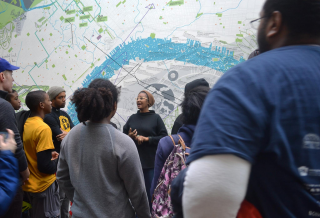
Background
“Maps are everywhere around us, ever present to help us navigate both public and personal geographies, or orient ourselves in communal and universal landscapes. But all maps come with an agenda—as much as maps can reveal about a place or idea, maps also have the power to hide or distort truths.”
– Black Quantum Futurism
Philadelphia Assembled is an expansive project that tells a story of radical community building and active resistance through the personal and collective narratives that make up Philadelphia's changing urban fabric. These narratives were be explored (2013-2017) through a collaborative effort between the Philadelphia Museum of Art and a team of individuals, collectives, and organizations as they experiment with multiple methodologies for amplifying and connecting relationships in Philadelphia's transforming landscape.
– phlassembled.net
The museum phase (September 9, 2017 - December 10, 2017) of Philadelphia Assembled hosted a large-scale indoor city panorama in the atrium space outside the Perelman galleries.
Each of the 5 panels suggested a new framework through which to see the shifting landscape of the city, addressing the narratives that are often made invisible by dominant systems and linear understandings of time. These range in scale from the personal, to the local, to the global.
Digitalized
After the closing of the PHLA exhibition the maps were digitalized by Maurits de Bruijn.
– Black Quantum Futurism
Philadelphia Assembled is an expansive project that tells a story of radical community building and active resistance through the personal and collective narratives that make up Philadelphia's changing urban fabric. These narratives were be explored (2013-2017) through a collaborative effort between the Philadelphia Museum of Art and a team of individuals, collectives, and organizations as they experiment with multiple methodologies for amplifying and connecting relationships in Philadelphia's transforming landscape.
– phlassembled.net
The museum phase (September 9, 2017 - December 10, 2017) of Philadelphia Assembled hosted a large-scale indoor city panorama in the atrium space outside the Perelman galleries.
Each of the 5 panels suggested a new framework through which to see the shifting landscape of the city, addressing the narratives that are often made invisible by dominant systems and linear understandings of time. These range in scale from the personal, to the local, to the global.
Digitalized
After the closing of the PHLA exhibition the maps were digitalized by Maurits de Bruijn.
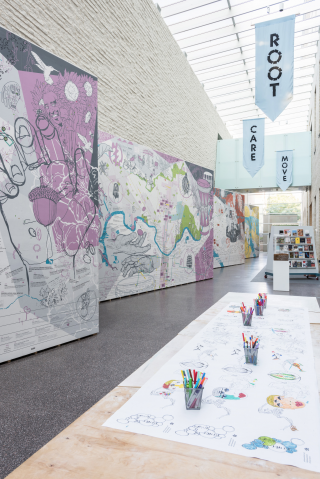
Regularly scheduled workshops offered the opportunity to continue to “deconstruct global, national, and local events, policies, and actions in relation to people power and acts of resistance/resilience across time, in order to reconstitute our collective histories.” Situated in the physical corridor of Perelman Building, the panorama provided context for the interweaving issues embodied within the project’s atmosphere, serving as a place of passage and learning as visitors enter into the galleries. As visitors joined for any of the upcoming programs they were invited to add to the images or data presented in this panorama.

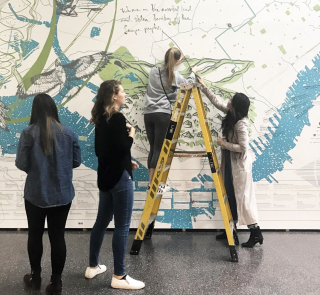
In this way, the panorama introduced PHLA visitors and participants to a spatial, non-linear, sense of history and future. These were neither comprehensive nor static images and narratives of our time, but rather served as a collection of dates derived from collaborators and project discussions, each entry a starting point for a conversation about our city’s history and experiences. While they depicted actual events in history, we recognize that the ‘gaps’ between these dates are of equal importance, and such ‘gaps’ were intended to be filled in with your own personal or historical acts of resistance or resilience.
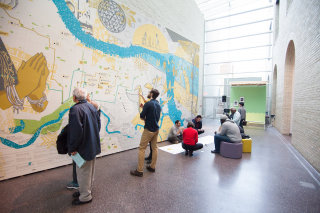
Individual Panels
Each panel was dedicated to reflecting one of the five atmospheres that make up Philadelphia Assembled, with the exception of Sovereignty, which covered two panels to account for histories of Land and Economic Sovereignty. These panels were grounded in both the concepts of the atmosphere, as well as the geographic section of Philadelphia where public programming in the city-wide phase (spring 2017) took place.
Timeline + Defining Scales of Time
Each panel had four scales of timelines consisting of key moments in global, national, and local history as related to the atmosphere, and a fourth timeline that charted “acts of resistance + resilience” (also interpreted as “Acts of Life” or “People Power”) flowing along the river. The timelines along the bottom of each panel provided a context that may have influenced, impacted, reacted to or led to the chosen acts of resistance and resilience - both directly and indirectly. Some of these dates were celebrated as positive steps towards inclusion and/or outcomes of the power of resistance. Other dates described the events, policies, theories, and organizations that are repressive and harmful toward communities, which also presented a context for communities’ resilience.
Each panel was dedicated to reflecting one of the five atmospheres that make up Philadelphia Assembled, with the exception of Sovereignty, which covered two panels to account for histories of Land and Economic Sovereignty. These panels were grounded in both the concepts of the atmosphere, as well as the geographic section of Philadelphia where public programming in the city-wide phase (spring 2017) took place.
Timeline + Defining Scales of Time
Each panel had four scales of timelines consisting of key moments in global, national, and local history as related to the atmosphere, and a fourth timeline that charted “acts of resistance + resilience” (also interpreted as “Acts of Life” or “People Power”) flowing along the river. The timelines along the bottom of each panel provided a context that may have influenced, impacted, reacted to or led to the chosen acts of resistance and resilience - both directly and indirectly. Some of these dates were celebrated as positive steps towards inclusion and/or outcomes of the power of resistance. Other dates described the events, policies, theories, and organizations that are repressive and harmful toward communities, which also presented a context for communities’ resilience.
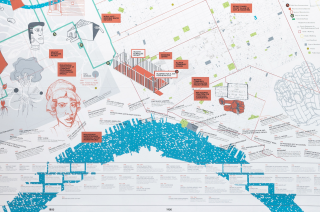
Each scale of time for this project can be understood as follows:
Global: key dates, events, policies, theories, organizations that exist or occurred outside of the political boundaries of the United States of America as related to the atmosphere.
National: key dates, events, policies, theories, and people that exist or occurred on the federal level or occurred outside of the State of Pennsylvania. This can include acts carried out on a national scale by individuals “sanctioned” by the national government.
Local: key dates, events, policies, theories, and people that exist or occurred by or within the State of Pennsylvania, including those specific to the City of Philadelphia. This can include acts carried out by individuals in the State of Pennsylvania “sanctioned” by federal, state, or city government.
People power: acts of resistance, resilience, and life related to the five PHLA “atmospheres” and their related concepts and collaborators that tells a “story of radical community building and active resistance through personal and collective narratives.” They are moments that cross all scales of time.
Some dates were repeated on more than one panel or described differently according to the atmosphere. When experiencing the Panorama and timelines, visitors were welcomed to decide that a date could/should have be listed on a different scale or dates could/should have be added or taken away, depending on their personal experience and community history. Engagement and dialogue on decolonizing historical narratives was welcomed in planned workshops, with other audience members, and online.
Orientation of the Map of Philadelphia
The map of Philadelphia was to scale and was reconfigured according to where public programming took place for each project atmosphere. The river that flowed throughout each panel helped orient which direction the map of Philadelphia is facing, as it does not follow the traditional compass. The green Mobile Futures Institute bus route (from the Futures atmosphere) also ran through each panel, as a means to orient the map and continuously reimagine (and re-orient) our futures.
Global: key dates, events, policies, theories, organizations that exist or occurred outside of the political boundaries of the United States of America as related to the atmosphere.
National: key dates, events, policies, theories, and people that exist or occurred on the federal level or occurred outside of the State of Pennsylvania. This can include acts carried out on a national scale by individuals “sanctioned” by the national government.
Local: key dates, events, policies, theories, and people that exist or occurred by or within the State of Pennsylvania, including those specific to the City of Philadelphia. This can include acts carried out by individuals in the State of Pennsylvania “sanctioned” by federal, state, or city government.
People power: acts of resistance, resilience, and life related to the five PHLA “atmospheres” and their related concepts and collaborators that tells a “story of radical community building and active resistance through personal and collective narratives.” They are moments that cross all scales of time.
Some dates were repeated on more than one panel or described differently according to the atmosphere. When experiencing the Panorama and timelines, visitors were welcomed to decide that a date could/should have be listed on a different scale or dates could/should have be added or taken away, depending on their personal experience and community history. Engagement and dialogue on decolonizing historical narratives was welcomed in planned workshops, with other audience members, and online.
Orientation of the Map of Philadelphia
The map of Philadelphia was to scale and was reconfigured according to where public programming took place for each project atmosphere. The river that flowed throughout each panel helped orient which direction the map of Philadelphia is facing, as it does not follow the traditional compass. The green Mobile Futures Institute bus route (from the Futures atmosphere) also ran through each panel, as a means to orient the map and continuously reimagine (and re-orient) our futures.
Stories of Illustrations
The illustrations for the panels described below gave supremacy to the life-affirming practices of communities involved and uplifted in/by the project. We acknowledge that prior to the colonization of land, peoples, and systems there were symbiotic relationships among indigenous cultures that must be included in all timekeeping. The drawings, like the data, were not exhaustive. We have drawn from the hope, science, and facts in stories from collaborators. The composition of the images gave supremacy to narratives that indicate a dream for the future, sovereign systems, the ability to reconstruct broken things and outdated ideas along with the safe keeping of life and resources not as reactions to colonialism, but the lives lived prior to its deep impacts.
Futures - A world that is decolonized and embraces, protects and honors the balance of masculinity and femininity in all beings. Gender, race, and class are remembered at useless constructs. The water is our source of life, and we affirm it’s livelihood as well. Our bodies, like the water, are clean of disease, and able to assimilate changes to its molecular structures easily without harm. It is a world where travel is easy and living beings, human and otherwise are safe to move around or stay put and live in harmony.
Land Sovereignty - We recognize that, in earth-based living, there is enough for all of us.
These two sides of this atmosphere are united through the cycle of birth, life, and death. We embrace this cycle, we accept the necessity of the passing of life through and to new forms.
Economic Sovereignty - We have our ways of surviving and thriving; both above and underground there is currency running through us.
Reconstructions - The expectation for any peoples is Mass freedom. We have built a new system for restoring justice to individuals and groups. Individuals and groups that have histories marred by systemic oppression have been vindicated and we have healed, generations to come celebrate the path that these people and groups have cleared for collective movement.
Sanctuary - The world is safe now. The cacophony of voices singing and saying their needs in unison are harmonious, and flow together like the waters. We remember that we are water beings, living on and of the land, listening and communing, feeding sameness and learning other people’s needs, not their differences. We prepare communal spaces for hearing. We are all fed and able to rest well from our meaningful work of living.
The illustrations for the panels described below gave supremacy to the life-affirming practices of communities involved and uplifted in/by the project. We acknowledge that prior to the colonization of land, peoples, and systems there were symbiotic relationships among indigenous cultures that must be included in all timekeeping. The drawings, like the data, were not exhaustive. We have drawn from the hope, science, and facts in stories from collaborators. The composition of the images gave supremacy to narratives that indicate a dream for the future, sovereign systems, the ability to reconstruct broken things and outdated ideas along with the safe keeping of life and resources not as reactions to colonialism, but the lives lived prior to its deep impacts.
Futures - A world that is decolonized and embraces, protects and honors the balance of masculinity and femininity in all beings. Gender, race, and class are remembered at useless constructs. The water is our source of life, and we affirm it’s livelihood as well. Our bodies, like the water, are clean of disease, and able to assimilate changes to its molecular structures easily without harm. It is a world where travel is easy and living beings, human and otherwise are safe to move around or stay put and live in harmony.
Land Sovereignty - We recognize that, in earth-based living, there is enough for all of us.
These two sides of this atmosphere are united through the cycle of birth, life, and death. We embrace this cycle, we accept the necessity of the passing of life through and to new forms.
Economic Sovereignty - We have our ways of surviving and thriving; both above and underground there is currency running through us.
Reconstructions - The expectation for any peoples is Mass freedom. We have built a new system for restoring justice to individuals and groups. Individuals and groups that have histories marred by systemic oppression have been vindicated and we have healed, generations to come celebrate the path that these people and groups have cleared for collective movement.
Sanctuary - The world is safe now. The cacophony of voices singing and saying their needs in unison are harmonious, and flow together like the waters. We remember that we are water beings, living on and of the land, listening and communing, feeding sameness and learning other people’s needs, not their differences. We prepare communal spaces for hearing. We are all fed and able to rest well from our meaningful work of living.